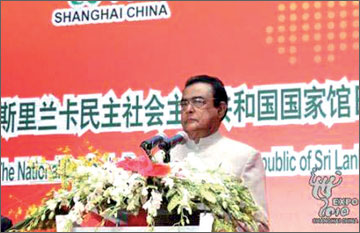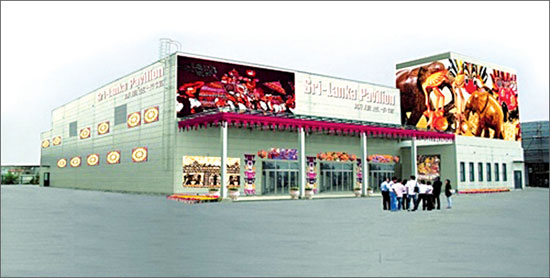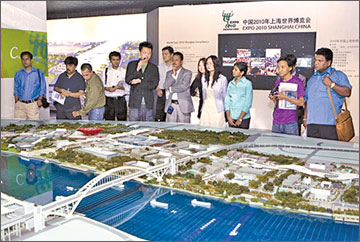Sri Lanka shines at Shanghai Expo 2010
by our Special correspondent in Shanghai
 Since 1851 when the Great Exhibition of Industries of All Nations was
held in London, the World Expositions have attained increasing
prominence as grand events for economic, scientific, technological and
cultural exchanges, serving as an important platform for displaying
historical experience, exchanging innovative ideas, demonstrating esprit
de corps and looking to the future. Since 1851 when the Great Exhibition of Industries of All Nations was
held in London, the World Expositions have attained increasing
prominence as grand events for economic, scientific, technological and
cultural exchanges, serving as an important platform for displaying
historical experience, exchanging innovative ideas, demonstrating esprit
de corps and looking to the future.
|

Prime Minister D.M. Jayaratne addressing the Expo in China |
With a long civilisation, China favours international exchange and
loves world peace. China owes its successful bid for the World
Exposition in 2010 to the international community’s support for and
confidence in its reform and opening-up. The Exposition is the first in
a developing country.
Expo 2010 Shanghai China is a great event to explore the full
potential of urban life in the 21st century and a significant period in
urban evolution. Fifty-five percent of the world population is expected
to live in cities by 2010. The prospect of future urban life, a subject
of global interest, concerns all nations, developed or less developed,
and their people. Being the first World Exposition on the theme of
‘city’, Exposition 2010 has attracted governments and people from across
the world. It focuses on the theme “Better City, Better Life”. During
its 184-days run, participants are displaying urban civilisation to the
full extent, with a view to exchange their experiences of urban
development, disseminate advanced notions on cities and explore new
approaches to human habitat, lifestyle and working conditions in the new
century. The stage is set to give opportunities to learn how to create
an eco-friendly society and maintain the sustainable development of
human beings.
The Shanghai Expo is a grand international gathering. On the one
hand, it has attracted 246 nations and international organisations to
take part in the exhibition and is on course to attract 70 million
visitors from home and abroad, thus breaking the record set by the Osaka
Expo in 1970 with 64 million visitors, ensuring the widest possible
participation in the history of the World Expositions. On the other
hand, Expo 2010 Shanghai has put China in a global perspective and has
done its best to encourage participation, gain understanding and support
of various countries and peoples, to turn the event into a happy reunion
of people from all over the world.
Besides, Expo 2010 Shanghai offers a wonderful opportunity for
cross-culture dialogues. Before the conclusion of the Exposition, a
“Shanghai Declaration” will be issued. This declaration, hopefully a
milestone in the history of the World Expositions, will symbolise the
insights to be offered by the participants and embody people’s ideas for
future cooperation and development and extensive common aspirations,
thereby leaving a rich legacy of urban development to people throughout
the world.
The Chinese Government has gone to great lengths to make the Shanghai
Expo a special event that carries on traditions and opens a new vista
into the future. The motto is: “Keeping in mind the next 60 years’
development while preparing for the six months’ Exposition.” China
counts on the continuing attention, support and participation of all the
peace-loving countries.
Today just after two and a half months since the opening, the
Shanghai Expo is in full swing. One Commissioner General summed up by
saying: “It’s like nothing I have ever seen before, every country on the
face of the earth is here, this is an epic event, the site alone is
twice the size of Monaco. Out of the 70 million people expected to
attend over the next six months, 95 percent will be Chinese, it will be
their first opportunity to get an impression of our country, our people,
culture and places.”
Although critics argue that in this developing country, US $ 58
billion could be better spent helping the country’s poor, with the theme
“Better City, Better Life,” for many nations it’s simply an opportunity
to showcase their countries and their cultures to millions of upwardly
mobile Chinese, many who have never left the country.
World Expos and major economies
|

Sri Lanka pavilion at Expo 2010 |
For those who make even a fleeting tour of the 2010 World Expo, they
cannot miss the essentials that have insinuated into and meandered
through all the expositions so far. Organisers in Shanghai are therefore
as assured as their predecessors, either in educated foresight or
calculated retrospect that what are on display at their Expo would be
morale-boosting to their visitors for years to come.
That’s perhaps why more and more people aspire to tour the grandiose
Expositions of their times, just to get the smack of the lift at least
mentally, if not physically.
London - The inaugural 1851 World Expo in London moved even
knowledgeable Queen Victoria to exclaim at the grandeur, fantasy and
excitement of the event.
Historians hold it that the London Exposition not only raised the
curtain on the British Victorian Era, but also epitomised the country’s
glory and dream heralded by the Industrial Revolution.
Technological advances not only turned Britain into a world factory,
but also made it the most powerful country in the world. The “British
Empire” had a quarter of the world population and a fifth of the global
land under its reign, at least nominally.
Chicago - The 1933 World Expo in Chicago is better remembered as one
that helped the host country to climb out of its 1929-1933 Great
Depression.
The Chicago Exposition enabled visitors to get a glimpse into what
has come to be known as the “country on wheels” and the makeshift
structures at the Expo boosted the development of new building material
and construction industries in the country.
Two years after the Chicago Expo, almost all the economic indicators
in the United States turned for the better as the country saw its GDP
rise from US$ 74.2 billion in 1933 to $ 204.9 billion in 1939.
It was the World Expo in Chicago that placed the host country into
the driver’s seat of the global modernisation process as well as a
leading role in the global economic development.
Osaka - The 1970 World Expo in Osaka, coupled with the 1964 Olympic
Games in Tokyo, served as a morale-booster to the Japanese who finally
parted with their shadows of defeat in World War II and moved toward
being a rising economic power in the world. These painstaking efforts of
two decades lifted Japan into the world’s number two economy, only
behind the United States.
As the first to be held in Asia, the Osaka Exposition was hailed as
the most successful World Expo with a record attendance of 64.2 million
visitors. The Osaka Expo even secured a strong momentum for nationwide
economic growth in the next 10 years.
Hannover - The 2000 World Expo in Hannover, Germany drew 150,000
visitors on its opening day. Public interests were trained and glued
onto sustainability of development.
Their emphasis on economic and ecological considerations helped
secure the German city, its status as the world’s leading exposition
host, and ushered in a new round of urban development centered on CBD or
central business district, fully-incorporated with the available
information technology.
“Grosser Garten” or Great Garden in English, which boosted CBD
development throughout Germany, has since developed into a
globally-accepted urban planning and sustainable urbanisation model.
Shanghai - Expo 2010 is a chance to showcase China to the rest of the
world and the rest of the world to the Chinese.
The 2010 World Expo is a great opportunity to showcase a country’s
achievements. Eight years ago, Shanghai won the bid to hold the 2010
Expo. Since then China had been preparing for the magnificent event with
precision planning and giving life to structures of the highest quality
and aesthetics. The event is not only an unprecedented stage for China
to display its economic and technological prowess, but also offers it a
chance to learn from the cutting-edge technological and cultural
achievements of the rest of the world.
Located in the Yangtze River Delta (YRD) region, Shanghai is China’s
most economically advanced and vibrant city, where the stimulus
generated by the Expo for the regional economy has been instant. Not
surprisingly, the “Expo economy” in the region had heated up even before
the event opened.
Wan Jifei, Deputy Director of the Shanghai Expo Organising Committee
and Chairman of China International Trade Promotion Committee, says one
unit of investment in the exhibition industry could result in nine units
of output in relevant sectors. During preparations, the “Expo economy”
stimulated 30 percent of the total investment in the YRD region.
The Expo is estimated to drive more than half of the total investment
in the region this year. The run-up to the event saw unprecedented
advancements in infrastructure construction in Shanghai and its
neighbouring areas in addition to the investments in the pavilions and
facilities on the 5.28-sq-km Expo site.
|

South Asian journalists at one of the stalls |
The aim of the Expo is more than just economic development. It is a
platform for Chinese and foreign cultures to communicate. It is a
magnificent platform to exhibit the latest technological and cultural
achievements of the entire human race.
Wu Jianmin, honorary president of the Bureau International des
Expositions, says the biggest gap between developed and under-developed
regions is not the stage of development, but ideas. The biggest
backwardness is that of ideas. And the Expo can help China and the other
countries to enrich them.
At this Expo, China presents to the world a country with a 5,000-year
history, which is enjoying fast development and changes through reform
and opening-up. For the host country, it has been said that while the
Olympics was China putting on a show for the world, the Expo is the
world putting on a show for China. The China Post reported that more
than anything, the Expo and the Olympics showed that China is now
capable of hosting the biggest international events. The country has
planned for a trilogy of great parties in the last two years, a
celebration of China’s ascension to the ranks of modern powers. It has
become visible with the opening ceremony of the Shanghai Expo 2010 that
the final instalment of the three-part act would end on a high note.
The three-part act comprising firstly the Beijing Olympic Games and
then the awe-inspiring 60th National Day parade last year and finally
the Shanghai Expo 2010, completed the hat-trick of China’s ‘coming-out’
parties. Just as the 1964 Tokyo Olympics and the 1970 Osaka Expo
signified the arrival of Japan as a post-war power, China’s three
parties’ signpost its current place in the 21st century world.
Having spent RMB80 billion on infrastructure construction on the 5.28
square kilometre Expo site, together with some construction of permanent
pieces of architecture “such as the national pavilion of China, the Expo
Boulevard, the Arts Performing Centre, as well as the Expo thematic
pavilion” the Shanghai Expo is well set to continue its objectives after
the end of the Expo.
The Urban Best Practices Area (UBPA), a first-time feature of World
Expos, has attracted many visitors since the Expo opened. The UBPA is a
platform for cities to exhibit and showcase their most successful
initiatives of various urban experiences, all of which focus on how to
improve the quality of life for residents.
The Expo park is a place where you can indulge all your senses. One
can listen to music of five continents and four oceans and see beautiful
scenes of art and culture from every corner of the globe. Above all the
Shanghai Expo has not failed to impress the visitors’ tastebuds with 128
restaurants dotted around pavilions. The Expo park provides more than
400,000 meals everyday. In addition to feeding the large number of
visitors, the Expo meets all tastes with selected delicacies from every
part of the world.
Sri Lanka Pavilion at Shanghai Expo
Sri Lanka has been participating at World Expos since 1985 and Sri
Lanka became one of the first countries to assure its support and
participation and also to sign the participants’ agreement with the
Bureau of Shanghai Expo.
At over 2,000 square metres, the Sri Lanka National Pavilion designed
by renowned Prof. Nimal De Silva is showcasing Sri Lankan culture,
historic cities and products and cuisine while celebrating the
friendship and cooperation between Sri Lanka and China. The Sri Lanka
Pavilion was opened to the visitors on the opening day of the Expo while
many others could not keep to this expected mark.
Features - The ceiling is painted with traditional batik craft and
walls are decorated with colourful national flags. Five distinctive
cities of Sri Lanka, all of which enjoy a long history, are being
displayed in an innovative and artistic way to review their histories.
The urban heritage is also presented to enlighten the world on how Sri
Lanka has achieved development together with preservation of its
cultural heritage.
Walking through the Sri Lanka Pavilion, one can see how, during the
early period the cities Anuradhapura, Polonnaruwa, Sigiriya, Galle and
Kandy were designed and built to accommodate the needs and ambitions of
man, at the same time having a deep respect for his environment. It
represents a proposal for a better city molded to man’s needs, one that
is livable and stimulating, beautiful and efficient.
Sri Lanka seeks to share the experiences of its own cities, which for
thousands of years have faced problems in balancing the protection of
historical inheritance with the needs of people and urban life.
“If there is something to take away after visiting the pavilion, we
hope visitors have a deeper understanding of the Sri Lankan way of life
from the passion we have for what we do, to the advancement and
originality of Sri Lankan people,” Ambassador Karunatilaka Amunugama
said after visiting the Sri Lanka Pavilion. China has caught the world’s
attention through Shanghai Expo 2010. For Sri Lanka it is a perfect
platform to introduce Sri Lanka to China and encourage more business,
trade and cultural exchanges between the two countries, he said.
Attending the opening of the Sri Lanka Pavilion, the Commercial
Counsellor said: “I think the Expo presents an important opportunity to
increase knowledge of Sri Lanka in China. Sri Lanka is well known for
its gems and tea and for its golden beaches and through this Expo we
want to show the Chinese and other international visitors, especially
the new generation of Chinese born after the 80s what Sri Lanka offers
to the world. Today Sri Lanka is in the fortunate position of being at
peace once more, meaning that the island that Marco Polo described as
‘the finest in the world’ is fully open for business and even more
importantly pleasure once again.”
“I hope the visitors have a deeper understanding of the Sri Lankan
culture, food and the creativity of our people, so I invite everyone to
visit Sri Lanka,” said the Commissioner General Hubert Jaykody who is a
veteran in World Expos, having engaged in more than 10 Expos in the past
as Commissioner General. He also serves as a member of the honoured
steering committee of the Commissioners General at the Shanghai Expo.
Expo 2010, if appropriately utilised will advance Sri Lanka’s foreign
and trade policy goals, strengthen economic, diplomatic and cultural
ties with China and shape and strengthen the ability to brand ‘Sri
Lanka’ in China. The tourism authority should go all out to boost the
number of people looking to visit Sri Lanka next year, through special
events being planned for the Expo 2010 in Shanghai.
National day of Sri Lanka Pavilion
Sri Lanka Pavilion’s National Day event on July 18 was one of the
highlights. Together with Sri Lankan Prime Minister D. M. Jayaratne,
Deputy Minister of Finance Dr. Sarath Amunugama, Mayor of Shanghai, Han
Zheng, Ambassador Karunatilaka Amunugama and other officials of the
Embassy and the Sri Lanka Consulate in Shanghai and thousands of Sri
Lankans and Chinese invitees marked Sri Lanka Day at Green Hall of the
Expo Center. The EXPO 2010 exhibition in Shanghai will be held for six
months and will be seen by a large number of people. Organisers expect
about 70 million visitors, of whom about 90 percent will be from China.
The Expo therefore presents an unprecedented opportunity for Sri Lanka
and all participating countries to showcase the potential of tourism.
Therefore, we believe that the Expo presents an excellent opportunity
to present Sri Lanka in the world’s most populous country and to promote
Sri Lanka as a place to visit for Asian tourists (primarily Chinese).
If we can make use of this opportunity, the investment is sure to
provide great benefits to the Sri Lankan economy in the long term.
|

